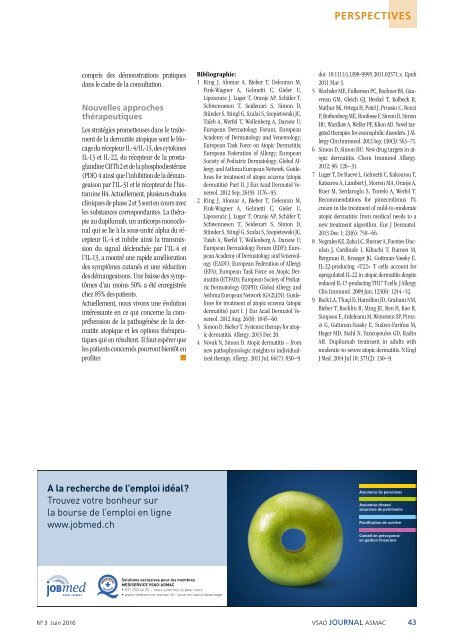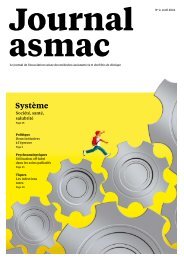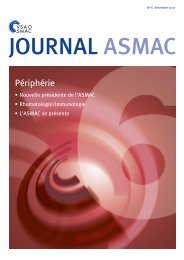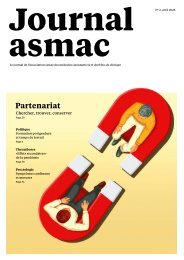Journal ASMAC No 3 - Juin 2016
Mystères - Interprofessionnalité Adieu Rosmarie Dermatologie / Oncologie
Mystères -
Interprofessionnalité
Adieu Rosmarie
Dermatologie / Oncologie
Create successful ePaper yourself
Turn your PDF publications into a flip-book with our unique Google optimized e-Paper software.
PERSPECTIVES<br />
compris des démonstrations pratiques<br />
dans le cadre de la consultation.<br />
<strong>No</strong>uvelles approches<br />
thérapeutiques<br />
Les stratégies prometteuses dans le traitement<br />
de la dermatite atopique sont le blocage<br />
du récepteur IL-4/IL-13, des cytokines<br />
IL-13 et IL-22, du récepteur de la prostaglandine<br />
CRTh2 et de la phosphodiestérase<br />
(PDE) 4 ainsi que l’inhibition de la démangeaison<br />
par l’IL-31 et le récepteur de l’histamine<br />
H4. Actuellement, plusieurs études<br />
cliniques de phase 2 et 3 sont en cours avec<br />
les substances correspondantes. La thérapie<br />
au dupilumab, un anticorps monoclonal<br />
qui se lie à la sous-unité alpha du récepteur<br />
IL-4 et inhibe ainsi la transmission<br />
du signal déclenchée par l’IL-4 et<br />
l’IL-13, a montré une rapide amélioration<br />
des symptômes cutanés et une réduction<br />
des démangeaisons. Une baisse des symptômes<br />
d’au moins 50% a été enregistrée<br />
chez 85% des patients.<br />
Actuellement, nous vivons une évolution<br />
intéressante en ce qui concerne la compréhension<br />
de la pathogénèse de la dermatite<br />
atopique et les options thérapeutiques<br />
qui en résultent. Il faut espérer que<br />
les patients concernés pourront bientôt en<br />
profiter.<br />
■<br />
Bibliographie:<br />
1 Ring J, Alomar A, Bieber T, Deleuran M,<br />
Fink-Wagner A, Gelmetti C, Gieler U,<br />
Lipozencic J, Luger T, Oranje AP, Schäfer T,<br />
Schwennesen T, Seidenari S, Simon D,<br />
Ständer S, Stingl G, Szalai S, Szepietowski JC,<br />
Taïeb A, Werfel T, Wollenberg A, Darsow U;<br />
European Dermatology Forum; European<br />
Academy of Dermatology and Venereology;<br />
European Task Force on Atopic Dermatitis;<br />
European Federation of Allergy; European<br />
Society of Pediatric Dermatology; Global Allergy<br />
and Asthma European Network. Guidelines<br />
for treatment of atopic eczema (atopic<br />
dermatitis) Part II. J Eur Acad Dermatol Venereol.<br />
2012 Sep; 26(9): 1176–93.<br />
2 Ring J, Alomar A, Bieber T, Deleuran M,<br />
Fink-Wagner A, Gelmetti C, Gieler U,<br />
Lipozencic J, Luger T, Oranje AP, Schäfer T,<br />
Schwennesen T, Seidenari S, Simon D,<br />
Ständer S, Stingl G, Szalai S, Szepietowski JC,<br />
Taïeb A, Werfel T, Wollenberg A, Darsow U;<br />
European Dermatology Forum (EDF); European<br />
Academy of Dermatology and Venereology<br />
(EADV); European Federation of Allergy<br />
(EFA); European Task Force on Atopic Dermatitis<br />
(ETFAD); European Society of Pediatric<br />
Dermatology (ESPD); Global Allergy and<br />
Asthma European Network (GA2LEN). Guidelines<br />
for treatment of atopic eczema (atopic<br />
dermatitis) part I. J Eur Acad Dermatol Venereol.<br />
2012 Aug; 26(8): 1045–60.<br />
3 Simon D, Bieber T. Systemic therapy for atopic<br />
dermatitis. Allergy. 2013 Dec 20.<br />
4 <strong>No</strong>vak N, Simon D. Atopic dermatitis – from<br />
new pathophysiologic insights to individualized<br />
therapy. Allergy. 2011 Jul; 66(7): 830–9.<br />
doi: 10.1111/j.1398-9995.2011.02571.x. Epub<br />
2011 Mar 3.<br />
5 Wechsler ME, Fulkerson PC, Bochner BS, Gauvreau<br />
GM, Gleich GJ, Henkel T, Kolbeck R,<br />
Mathur SK, Ortega H, Patel J, Prussin C, Renzi<br />
P, Rothenberg ME, Roufosse F, Simon D, Simon<br />
HU, Wardlaw A, Weller PF, Klion AD. <strong>No</strong>vel targeted<br />
therapies for eosinophilic disorders. J Allergy<br />
Clin Immunol. 2012 Sep; 130(3): 563–71.<br />
6 Simon D, Simon HU. New drug targets in atopic<br />
dermatitis. Chem Immunol Allergy.<br />
2012; 96: 126–31.<br />
7 Luger T, De Raeve L, Gelmetti C, Kakourou T,<br />
Katsarou A, Lambert J, Morren MA, Oranje A,<br />
Ruer M, Serdaroglu S, Torrelo A, Werfel T.<br />
Recommendations for pimecrolimus 1%<br />
cream in the treatment of mild-to-moderate<br />
atopic dermatitis: from medical needs to a<br />
new treatment algorithm. Eur J Dermatol.<br />
2013 Dec 1; 23(6): 758–66.<br />
8 <strong>No</strong>grales KE, Zaba LC, Shemer A, Fuentes-Duculan<br />
J, Cardinale I, Kikuchi T, Ramon M,<br />
Bergman R, Krueger JG, Guttman-Yassky E.<br />
IL-22-producing «T22» T cells account for<br />
upregulated IL-22 in atopic dermatitis despite<br />
reduced IL-17-producing TH17 T cells. J Allergy<br />
Clin Immunol. 2009 Jun; 123(6): 1244–52.<br />
9 Beck LA, Thaçi D, Hamilton JD, Graham NM,<br />
Bieber T, Rocklin R, Ming JE, Ren H, Kao R,<br />
Simpson E, Ardeleanu M, Weinstein SP, Pirozzi<br />
G, Guttman-Yassky E, Suárez-Fariñas M,<br />
Hager MD, Stahl N, Yancopoulos GD, Radin<br />
AR. Dupilumab treatment in adults with<br />
moderate-to-severe atopic dermatitis. N Engl<br />
J Med. 2014 Jul 10; 371(2): 130–9.<br />
N o 3 <strong>Juin</strong> <strong>2016</strong><br />
VSAO JOURNAL <strong>ASMAC</strong><br />
43


















